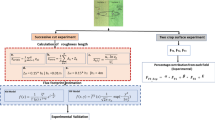Abstract
Flux footprint models delineate the source area of micrometeorological fluxes as measured by the eddy covariance (EC) system. An accurate knowledge of flux footprint is crucial for effective interpretation of measured fluxes and upscaling to a regional scale with the help of satellite data. Flux footprint models are derived based on the assumption that “measured fluxes are originated from a homogeneous cropland system.” For small and fragmented land-holdings of the Indian agricultural system, this assumption is often violated, hence questioning the applicability of existing models. The objective of this paper is to evaluate the performance of various footprint models to a mixed fetch (heterogeneous) cropland system. Field-scale experiments were conducted in continuous cotton (C3) sugarcane (C4) plots located in Nandikandi village, Telangana, India. Two low height EC towers capturing homogeneous fluxes from individual fields and one tall EC tower capturing heterogeneous fluxes from the combinations were used in the study. Half hourly fluxes are calculated as the covariance between vertical wind velocity and scalar concentration of interest (water vapor, air temperature, or carbon dioxide). Three analytical models (viz. Hsieh, Schuepp, and Kormann and Meixner) were applied along with the Lagrangian particle dispersion model, considering unstable (daytime) and stable (night time) flux measurements. Our results conclude that, for homogeneous croplands, the Schuepp model performs best during unstable atmospheric condition and Hsieh model performs best in stable atmospheric conditions. Hseih model is suitable in representing the source area fluxes in a mixed fetch condition for all atmospheric stability conditions.
Access this chapter
Tax calculation will be finalised at checkout
Purchases are for personal use only
Similar content being viewed by others
References
Arriga N, Rannik Ü, Aubinet M, Carrara A, Vesala T, Papale D (2017) Experimental validation of footprint models for eddy covariance CO2 flux measurements above grassland by means of natural and artificial tracers. Agric For Meteorol 15(242):75–84
Aubinet M, Grelle A, Ibrom A, Rannik Ü, Moncrieff J, Foken T, Kowalski AS, Martin PH, Berbigier P, Bernhofer C, Clement R (1999) Estimates of the annual net carbon and water exchange of forests: the EUROFLUX methodology. In: Advances in ecological research, vol 30, pp 113–175. Academic Press
Finnigan JJ (2004) A re-evaluation of long-term flux measurement techniques part II: coordinate systems. Bound-Layer Meteorol 113(1):1–41
Foken T, Leclerc MY (2004) Methods and limitations in validation of footprint models. Agric For Meteol 127(3–4):223–34
Foken T, Wichura B (1996) Tools for quality assessment of surface-based flux measurements. Agric for Meteorol 78(1–2):83–105
Horst TW, Weil J (1992) Footprint estimation for scalar flux measurements in the atmospheric surface layer. Bound-Layer Meteorol 59(3):279–296
Hsieh CI, Katul G, Chi TW (2000) An approximate analytical model for footprint estimation of scalar fluxes in thermally stratified atmospheric flows. Adv Water Resour 23(7):765–772
Kaimal JC, Finnigan JJ (1994) Atmospheric boundary layer flows: their structure and measurement. Oxford university press
Kljun N, Calanca P, Rotach MW, Schmid HP (2004) A simple parameterisation for flux footprint predictions. Bound-Layer Meteorol 112(3):503–523
Kolari P, Pumpanen J, Rannik Ü, Ilvesniemi H, Hari P, Berninger F (2004) Carbon balance of different aged Scots pine forests in Southern Finland. Glob Change Biol 10(7):1106–1119
Pasquill F, Smith FB (1983) Atmospheric diffusion: study of the dispersion of windborne material from industrial and other sources. Wiley, New York
Rannik Ü, Aubinet M, Kurbanmuradov O, Sabelfeld KK, Markkanen T, Vesala T (2000) Footprint analysis for measurements over a heterogeneous forest. Bound-Layer Meteorol 97(1):137–166
Schmid HP (1994) Source areas for scalars and scalar fluxes. Bound-Layer Meteorol 67(3):293–318
Schmid HP (2002) Footprint modeling for vegetation atmosphere exchange studies: a review and perspective. Agric For Meteorol 113(1):159–183
Van de Boer A, Moene AF, Schüttemeyer D, Graf A (2013) Sensitivity and uncertainty of analytical footprint models according to a combined natural tracer and ensemble approach. Agric For Meteorol 15(169):1–1
Wilson JD, Swaters GE (1991) The source area influencing a measurement in the planetary boundary layer: the “footprint” and the “distribution of contact distance.” Bound-Layer Meteorol 55(1–2):25–46
Author information
Authors and Affiliations
Editor information
Editors and Affiliations
Rights and permissions
Copyright information
© 2021 The Author(s), under exclusive license to Springer Nature Switzerland AG
About this chapter
Cite this chapter
Kumari, S., Phanindra, K.B.V.N. (2021). Comparison of Flux Footprint Models to a Mixed Fetch Heterogeneous Cropland System. In: Jha, R., Singh, V.P., Singh, V., Roy, L., Thendiyath, R. (eds) Water Resources Management and Reservoir Operation . Water Science and Technology Library, vol 107. Springer, Cham. https://doi.org/10.1007/978-3-030-79400-2_8
Download citation
DOI: https://doi.org/10.1007/978-3-030-79400-2_8
Published:
Publisher Name: Springer, Cham
Print ISBN: 978-3-030-79399-9
Online ISBN: 978-3-030-79400-2
eBook Packages: Earth and Environmental ScienceEarth and Environmental Science (R0)




